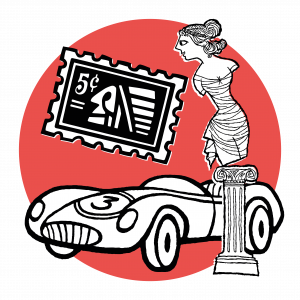This article was originally published in March 2018.
One of the first questions we are always asked by new bidders at an auction is, ‘will it make me money?’ Our answer? The infuriatingly mercurial, ‘perhaps.’ Choosing a classic or collectors’ car is a deeply personal process, and for each buyer seeking a pristine, track-ready Ferrari, there is another looking for a Bugatti that appears to be more rust than racing car. Every bidder who attends our sale is looking for a different car for a different purpose, but we give the same advice to them all: buy what you love.

To buy a classic car purely for investment is, although understandable, to rather miss the fun. The value in a car lies in its history; in the laps it has scorched around Brooklands and Le Mans, in the creaking leather seats occupied by the bravest world champions, and in the paint of Grand Prix rivals etched on to its bumper after a run-in at Eau Rouge. It is in a gloriously sunny Autumnal Sunday, an empty road and no particular destination in mind. It is in experiences that cannot be valued at an exact price, but ones that leave you all the richer for them.
There will always be those who boast they can read the market and predict the meteoric rise of a currently underrated classic just in time to cash in, but there are just as many who end up with a garage filled with unwanted vehicles that they curse beneath their car covers as the top prices they were promised fail to materialise. 10 years ago, who could have predicted the continued rise of the 80s and 90s hot hatches? Who thought that the BMW M3 saloon would be anything other than simply a dependable used car? It is safe to assume that those who chose to hang on to theirs did so out of love for their cars rather than any ‘insider knowledge,’ and just so happened to get lucky. Classic cars are expensive to maintain, and you’ll feel every penny if you do not truly love the machine sitting on the driveway, be it a Lamborghini or a Lambretta.

That said, once you’ve identified your dream car, there are certain strategies to follow that can increase your chances of potential profit. Rarity, provenance, condition and originality are the four cornerstones of any solid motoring auction purchase, and ones which can and should be applied even to entry-level acquisitions. Your car of choice may have been mass-produced, but a highly original and pristine example with interesting ownership will always be a more ‘future-proof’ investment than a run-down model with out-moded modifications.
Two of Bonhams most celebrated sales are on the approach; Les Grandes Marques du Monde à Monaco in May and The Aston Martin Sale in June. Both are already populated by a broad range of classic and collectors’ motor cars, but there are two in particular that stand out, both of which perfectly illustrate the cornerstones of buying at auction.
Aston Martin is a marque that has truly stood the test of time (and should continue to do so) for several reasons. It embodies classic design, high performance and reliability across its entire range, and when combined with stellar provenance, it is a marque that can perform seriously well at auction and hold its value. In December, we offered Sir Paul McCartney’s DB5 which sold for a world-record breaking £1.3M – the car would have cost £4,175 new, not a bad return. The 1959 Aston Martin DB4 Series 1, estimated at £380,000-440,000, coming to the Aston Martin Sale can be considered the thinking man’s DB5. Half the price (for a standard model, at least) yet still an elegant and powerful grand tourer from one of the most lauded British marques in existence. This example is one of the first 50 ever built, has matching numbers throughout, is finished in period-appropriate silver and has been beautifully maintained throughout its life – everything you should be looking for when investing in a classic car.
Interesting provenance is the final piece of the puzzle, and it doesn’t come much more impressive than the ex-Aryton Senna, Monaco Grand Prix-winning, 1993 McLaren MP4/8A which will be offered at our Monaco sale in May. If you are looking to invest in a racing car, then this has to be the one. It has unrivalled history, has been flawlessly maintained and was raced by one of the most glamorous and evocative names in motorsport, attributes that will help such a valuable machine weather the inevitable fluctuations in demand for specialist Formula 1 cars.

These fluctuations come and go, as with all markets. This is particularly worth bearing in mind with the new supercars which are currently being bought up and sold on a year later at sometimes triple the price. It may seem appealing that a Ferrari LaFerrari bought in 2016 for £1.6M was changing hands at closer to £3M by early 2017, but there is no way of knowing where the market will go next, making it a riskier investment than it first appears. History is an invaluable tool in the classic car world and allows safer predictions to be made – early Jaguar E-Types, for example, have been consistently increasing in value over the past decade – whereas modern supercars are uncharted territory. They tend to be used as benchmarks by rival brands who aim to just that little bit sharper, faster and leaner, meaning that they can date far more quickly than more established models and thus decline in value. A 2012 Ferrari FF was retailing at £226,000 when first released, and is now averaging £120,000, bringing us back to the absolute importance of buying a car you will love enough to consider a loss of more than £100,000 small change in comparison to the joy it brings!
In what is essentially a hobbyists market, to treat cars as one would stocks and shares is to misunderstand where their value lies – invest your time, invest your enthusiasm, invest your passion and the rewards will be great.








